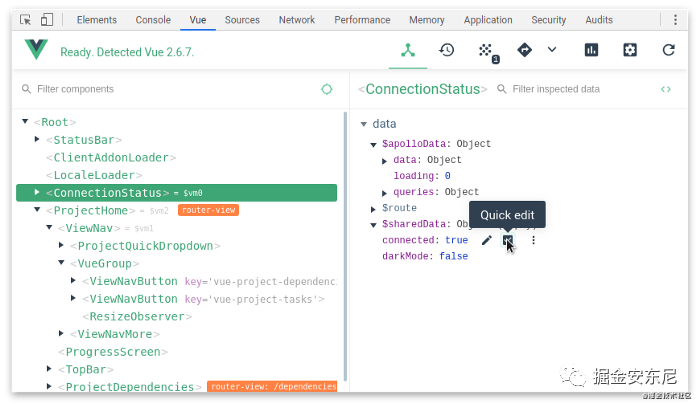【深入浅出】Vue3 虚拟 DOM
关注并将「趣谈前端」设为星标
每日定时推送技术干货/优秀开源/技术思维
序言
首发在我的博客 深入 Vue3 虚拟 DOM
译自:diving-into-the-vue-3s-virtual-dom-medium
作者:Lachlan Miller
此篇我们将深入 Vue3 虚拟 DOM,以及了解它是如何遍历找到对应 vnode 的。
多数情况下我们不需要考虑 Vue 组件内部是如何构成的。但有一些库会帮助我们理解,比如 Vue Test Utils 的 findComponent 函数。还有一个我们都应该很熟悉的 Vue 开发工具 —— Vue DevTools,它显示了应用的组件层次结构,并且我们可以对它进行编辑操作等。

我们本篇要做的是:实现 Vue Test Utils API 的一部分,即 findComponent 函数。
设计 findComponent
首先,我们都知道虚拟 DOM 是基于“提升性能”提出的,当数据发生变化时,Vue 会判断此是否需要进行更新、或进行表达式的计算、或进行最终的 DOM 更新。
比如这样:
- div
- span (show: true)
- 'Visible'
它的内部层次关系是:
HTMLDivElement -> HTMLSpanElement -> TextNode
如果 show 属性变成 false。Vue 虚拟 DOM 会进行如下更新:
- div
- span (show: false)
- 'Visible'
接着,Vue 会更新 DOM,移除'span' 元素。
那么,我们设想一下,findComponent 函数,它的调用可能会是类似这样的结构:
const { createApp } = require('vue')
const App = {
template: `
<C>
<B>
<A />
</B>
</C>
`
}
const app = createApp(App).mount('#app')
const component = findComponent(A, { within: app })
// 我们通过 findComponent 方法找到了 <A/> 标签。
打印 findComponent
接着,我们先写几个简单组件,如下:
// import jsdom-global. We need a global `document` for this to work.
require('jsdom-global')()
const { createApp, h } = require('vue')
// some components
const A = {
name: 'A',
data() {
return { msg: 'msg' }
},
render() {
return h('div', 'A')
}
}
const B = {
name: 'B',
render() {
return h('span', h(A))
}
}
const C = {
name: 'C',
data() {
return { foo: 'bar' }
},
render() {
return h('p', { id: 'a', foo: this.foo }, h(B))
}
}
// mount the app!
const app = createApp(C).mount(document.createElement('div'))
我们需要在 Node.js v14+ 环境,因为我们要用到 可选链。且需要安装 Vue、jsdom 和 jsdom-global。
我们可以看到 A , B , C 三个组件,其中 A , C 组件有 data 属性,它会帮助我们深入研究 VDOM。
你可以打印试试:
console.log(app)
console.log(Object.keys(app))
结果为 {},因为 Object.keys 只会显示可枚举的属性。
我们可以尝试打印隐藏的不可枚举的属性:
console.log(app.$)
可以得到大量输出信息:
<ref *1> {
uid: 0,
vnode: {
__v_isVNode: true,
__v_skip: true,
type: {
name: 'C',
data: [Function: data],
render: [Function: render],
__props: []
}, // hundreds of lines ...
再打印:
console.log(Object.keys(app.$))
输出:
Press ENTER or type command to continue
[
'uid', 'vnode', 'type', 'parent', 'appContext', 'root', 'next', 'subTree', 'update', 'render', 'proxy', 'withProxy', 'effects', 'provides', 'accessCache', 'renderCache', 'ctx', 'data', 'props', 'attrs', 'slots', 'refs', 'setupState', 'setupContext', 'suspense', 'asyncDep', 'asyncResolved', 'isMounted', 'isUnmounted', 'isDeactivated', 'bc', 'c', 'bm', 'm', 'bu', 'u', 'um', 'bum', 'da', 'a', 'rtg', 'rtc', 'ec', 'emit', 'emitted'
]
我们可以看到一些很熟悉的属性:比如 slots、data,suspense 是一个新特性,emit 无需多言。还有比如 attrs、bc、 c、bm 这些是生命周期钩子:bc 是 beforeCreate, c 是 created。也有一些内部唯一的生命周期钩子,如 rtg,也就是 renderTriggered, 当 props 或 data 发生变化时,用于更新操作,从而再渲染。
本篇我们需要特别关注的是:
vnode、subTree、component、type和children。
匹配 findComponent
来先看 vnode,它有很多属性,我们需要关注的是 type 和 component 这两个。
// 打印 console.log(app.$.vnode.component)
console.log(app.$.vnode.component)
<ref *1> {
uid: 0,
vnode: {
__v_isVNode: true,
__v_skip: true,
type: {
name: 'C',
data: [Function: data],
render: [Function: render],
__props: []
}, // ... many more things ... } }
type 很有意思!它与我们之前定义的 C 组件一样,我们可以看到它也有 [Function: data](我们在前面定义了一个 msg 数据是我们的查找目标)。实际上我们尝试可以做以下打印:
console.log(C === app.$.vnode.component.type) //=> true
天呐!二者竟然是相等的!😮
console.log(C === app.$.vnode.type) //=> true
这样也是相等的!😮
(你是否会疑问这两个属性为什么会指向同一个对象?这里先暂且按下不表、自行探索。)
无论如何,我们算是得到了寻找到组件的途径。
通过这里的找寻过程,我们还能再进一步得到以下相等关系:
console.log(
app.$
.subTree.children[0].component
.subTree.children[0].component.type === A) //=> true
在本例中,div 节点的 subTree.children 数组长度是 2 。我们知道了虚拟 DOM 的递归机制,就可以沿着这个方向:subTree -> children -> component 来给出我们的递归解决方案。
实现 findComponent
我们首先实现 matches 函数,用于判断是当前 vnode 节点和目标是否相等。
function matches(vnode, target) {
return vnode?.type === target
}
然后是 findComponent 函数,它是我们调用并查找内部递归函数的公共 API。
function findComponent(comp, { within }) {
const result = find([within.$], comp)
if (result) {
return result
}
}
此处的 find 方法的实现是我们要重点讨论的。
我们知道写递归,最重要的是判断什么时候结束 loop,所以 find 函数应该先是这样的:
function find(vnodes, target) {
if (!Array.isArray(vnodes)) {
return
}
}
然后,在遍历 vnode 时,如果找到匹配的组件,则将其返回。如果找不到匹配的组件,则可能需要检查 vnode.subTree.children 是否已定义,从而更深层次的查询及匹配。最后,如果都没有,我们则返回累加器 acc。所以,代码如下:
function find(vnodes, target) {
if (!Array.isArray(vnodes)) {
return
}
return vnodes.reduce((acc, vnode) => {
if (matches(vnode, target)) {
return vnode
}
if (vnode?.subTree?.children) {
return find(vnode.subTree.children, target)
}
return acc
}, {})
}
如果你在 if (vnode?.subTree?.children) { 这里进行一个打印 console.log,你能找到 B 组件,但是我们的目标 A 组件的路径如下:
app.$
.subTree.children[0].component
.subTree.children[0].component.type === A) //=> true
所以我们再次调用了 find 方法:find(vnode.subTree.children, target),在下一次迭代中查找的第一个参数将是app.$.subTree.children,它是 vnode 的数组。我们不仅需要检查vnode.subTree.children,还需要检查vnode.component.subTree。
所以,最后 find 方法如下:
function find(vnodes, target) {
if (!Array.isArray(vnodes)) {
return
}
return vnodes.reduce((acc, vnode) => {
if (matches(vnode, target)) {
return vnode
}
if (vnode?.subTree?.children) {
return find(vnode.subTree.children, target)
}
if (vnode?.component?.subTree) {
return find(vnode.component.subTree.children, target)
}
return acc
}, {})
}
然后我们再调用它:
const result = findComponent(A, { within: app })
console.log( result.component.proxy.msg ) // => 'msg'
我们成功了!通过 findComponent,找到了 msg!
如果你以前使用过 Vue Test Utils,可能见过类似的东西 wrapper.vm.msg,它实际上是在内部访问 proxy(对于Vue 3)或 vm(对于Vue 2)。
小结
本篇的实现并非完美,现实实现上还需要执行更多检查。例如,如果使用 template或 Suspense组件时,需要作更多判断。不过这些你可以在 Vue Test Utils 源码 中可以看到,希望能帮助你进一步理解虚拟 DOM。
❤️ 看完三件事
如果你觉得这篇内容对你挺有启发,我想邀请你帮我三个小忙:
点个【在看】,或者分享转发,让更多的人也能看到这篇内容 关注公众号【趣谈前端】,定期分享 工程化 / 可视化 / 低代码 / 优秀开源。

基于Koa + React + TS从零开发全栈文档编辑器(进阶实战)
点个在看你最好看

